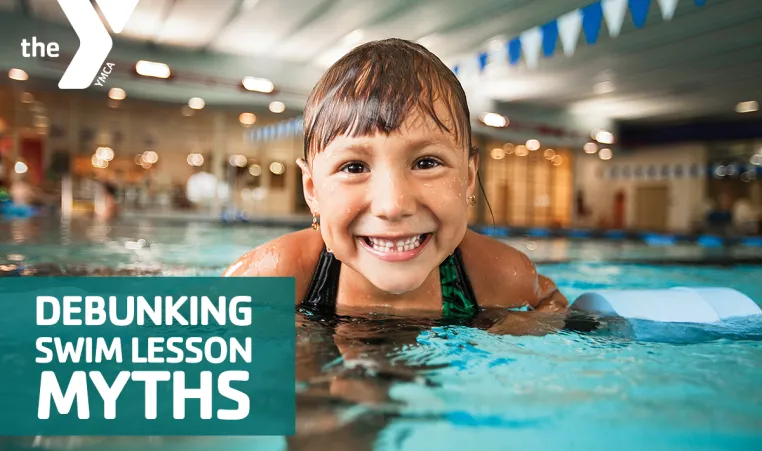
Teaching children how to be safe in and around water is one of the most important life skills parents can help their children learn. It not only saves lives; it builds confidence. The Y’s swim lessons and water safety programs work to eliminate drowning by providing swim lessons to children.
Drowning continues to be the leading cause of accidental death among child ages 1 to 4, and experts report that 88 percent of preschooler drownings could have been avoided with formal swim lessons. Older children are also at risk. Drowning is the second-leading cause of deather for children ages 1 to 14.
To make sure you and your family are safe, know what is fact and fiction when it comes to swim lessons and water safety.
Myth #1: Kids should take swim lessons when they start school.
False.
The facts: To avoid accidental drowning and equip your child with essential survival skills, kids should begin swim lessons as early as six months in a parent/child setting. Water is a danger everywhere, so the earlier a child learns to swim and be safe around water, the better.
The Y recommends starting swim lessons at the age of six months in a parent/child class where parents can also learn important safety techniques. Getting your child comfortable with being in the water, even if they cannot swim independently, is an important first step that will make tackling swimming techniques and correct strokes easier and more fun to learn.
Myth #2: Swimming with arm floaties can protect your child and help them learn.
False.
The facts: Swimming with floaties will not protect your child, and they come with risks.
Arm floaties hold the body in a vertical position, not in a proper horizontal position for swimming. So if a child used to wearing floaties accidentally slips into the pool without the floaties, they will struggle to keep themselves above water because they haven't learned proper swimming techniques.
Plus, floaties are unreliable. Arm floaties can slide off, pop or deflate. If a child wearing floaties begins to struggle, the floaties hold the body in an upright position, but that could mean that only the child’s arms are above water.
The Y recommends a Coast Guard-approved life vest to be used by non-swimmers. But even when a child is wearing the vest, parents must have the child within arm’s reach and keep a close eye on them to keep them safe in the water at all times.
Myth #3: As long as we practice during the summer, my child will be ready to advance to the next swim class.
False.
The facts: Your child should practice swimming year round if you want them to continue to advance. Not only is this smart for safety reasons, but swimming is also a wonderful exercise for children and adults.
Indoor swimming pools are a great way to continue swimming lessons all year or even just to practice. They also are a good way to get your child used to the water, because indoor pools are typically warmer.
Many parents believe their children will automatically advance to the next class each summer. But unfortunately when kids only take lessons each June or July, they sometimes need to repeat a level. If you're not sure what level your child belongs in, just ask about a free assessment or use our online swim lesson level selector to find the best fit.
Myth #4: A parent's reaction to their child’s swimming progress is irrelevant.
False.
The facts: The way that you react as the parent can truly help your child learn to swim. Be careful to consider your words, behaviors and even facial expressions when your child is learning how to swim. If your child coughs, goes under water for the first time, gasps or screams, remain calm. Avoid getting involved in your child's lesson to allow your child will build more confidence and also build trust in the instructor.
Be sure to give them smiles, recognize them for using correct techniques and support the instructor’s teachings. A child will not be able to learn the correct swimming techniques if they are scared, don't trust the instructor, or are concerned about your reaction.
Myth #5: The lifeguard is always watching, so it’s okay to let your kids be independent while in the water.
False.
The facts: Even if your children are old enough to go down the slide, go to the bathroom, or hit up the concession stand by themselves, you should always keep an eye on them. Parents should avoid distractions such as phone calls, texting, watching videos, looking at social media and reading. All of these activities can cause you to lose track of time and lose track of what your child is doing.
Despite the fact that lifeguards are professionally trained to rescue your child, you know your child best and can alert a lifeguard if your child appears to be struggling in the water.
Drowning is usually a silent accident and happens quickly. While the lifeguard on duty is carefully checking the pool, parents are asked to be mindful of their own children. Be sure to be alert and always track your child or children while they’re at the pool, no matter how old they are. Parents should always be within arm’s reach of non-swimmers.
The best protection is to make sure your child knows how to swim. As a nonprofit, the Y offers financial assistance to families in need so that all in need have the opportunity to take swim lessons and learn water safety and swim skills. Learn more about Y swim lessons and register online.





